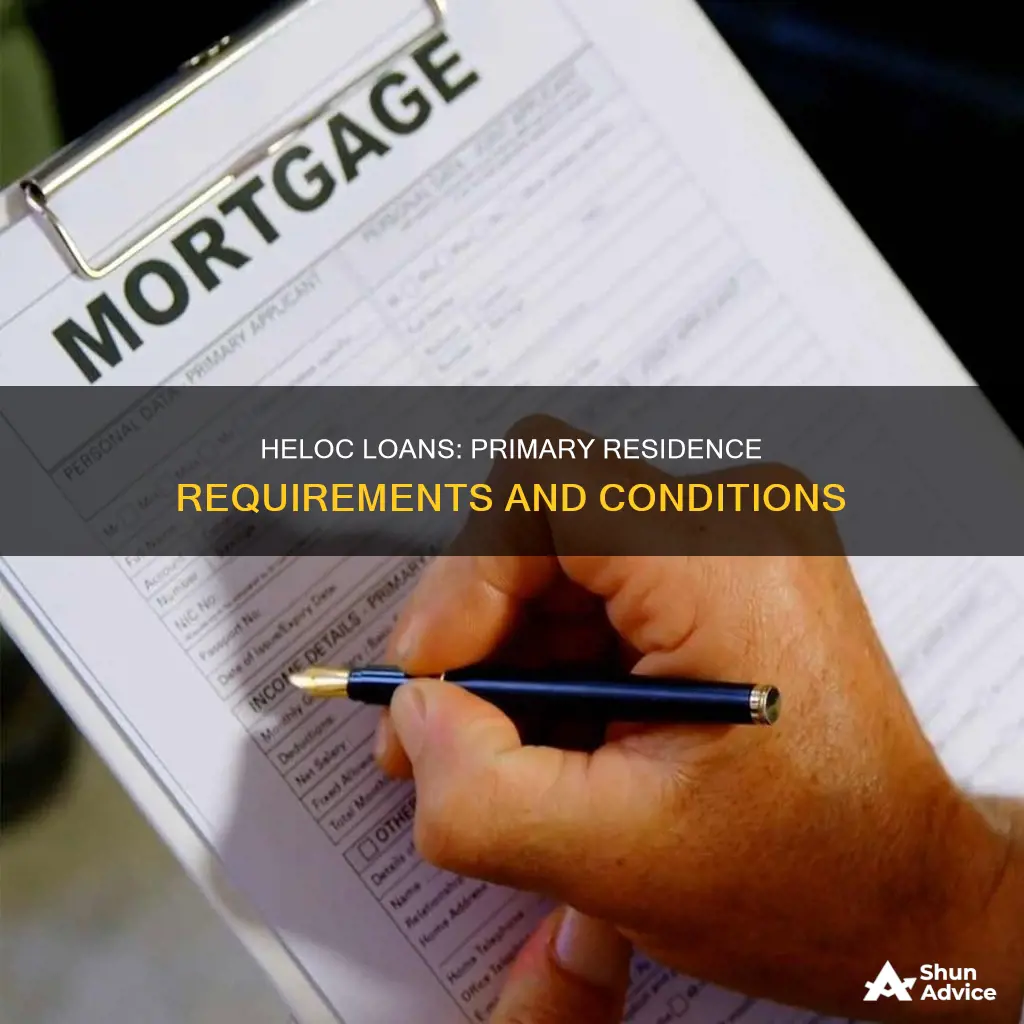
Home Equity Lines of Credit (HELOC) are a great way to access funds without having to take out a high-interest, unsecured personal loan. A HELOC can be taken out on a primary residence or an investment property. However, there are some key differences between the two. For a primary residence, it is generally easier to qualify for a HELOC and the interest rates are usually lower. On the other hand, a HELOC on an investment property is considered riskier by lenders and therefore has more stringent eligibility criteria and higher interest rates and fees. When assessing eligibility for a HELOC, lenders will consider the borrower's credit score and history, debt-to-income ratio, and the loan-to-value ratio of the property.
| Characteristics | Values |
|---|---|
| Residency requirement | No residency requirement for HELOC qualification. |
| Ease of qualification | Easier to qualify for a HELOC on a primary residence than an investment property. |
| Interest rates | Interest rates for HELOCs on investment properties are higher compared to primary residences. |
| Fees | HELOCs on investment properties may have higher fees. |
| Risk | Lenders consider HELOCs on investment properties to be riskier. |
| Collateral | A HELOC on an investment property uses a place where the borrower does not live as collateral for a loan. |
| Lender preference | Lenders prefer to offer HELOCs on primary residences. |
| Credit score | A credit score of 700 or higher is ideal for most lenders. |
| Payment history | A good payment history is essential for securing a HELOC. |
| Debt-to-income ratio | A low debt-to-income ratio can increase the likelihood of being approved. |
| Income documentation | Income documentation is required to confirm the ability to make regular payments. |
| Equity | Substantial equity in the home (15-20%) or 20-40% is required for HELOC eligibility. |
What You'll Learn
- HELOCs are available for both primary residences and investment properties
- HELOCs on primary residences are easier to obtain and have lower interest rates
- Lenders consider HELOCs on investment properties riskier, so they have higher interest rates and fees
- To qualify for a HELOC, you need a good credit score, low debt-to-income ratio, and substantial equity in your home
- HELOCs provide flexible access to cash, but you risk foreclosure if you default on the loan

HELOCs are available for both primary residences and investment properties
A Home Equity Line of Credit (HELOC) is a loan taken out against a piece of real estate. HELOCs are available for both primary residences and investment properties. However, there are some key differences between the two.
Lenders typically view HELOCs on primary residences as lower risk, as they know the borrower is more likely to prioritise repaying a loan on their primary residence. As a result, HELOCs on primary residences are generally easier to qualify for and have lower interest rates and fees.
On the other hand, HELOCs on investment properties are considered riskier by lenders, as the borrower's cash flow is tied up in multiple rental properties, increasing the risk of default. Due to this increased risk, lenders may have stricter requirements for HELOCs on investment properties, and these loans may come with higher interest rates and fees.
To be eligible for a HELOC on a primary residence or investment property, borrowers typically need to have a strong credit score and a low debt-to-income ratio. Lenders will also consider the loan-to-value (LTV) ratio and the combined loan-to-value (CLTV) ratio, which takes into account the debt on the property against its value. Additionally, having substantial equity in the property, typically between 15 to 40%, is important for qualifying for a HELOC.
While HELOCs on investment properties may come with additional challenges and costs, they can still be a viable option for borrowers looking to utilise the equity in their investment properties.
FSA Equipment Loans: What You Need to Know
You may want to see also

HELOCs on primary residences are easier to obtain and have lower interest rates
HELOCs, or Home Equity Lines of Credit, are generally easier to obtain and have lower interest rates when they are on primary residences. This is because lenders view loans on primary residences as lower-risk investments. Since the borrower's actual residence is used as collateral, lenders know that the borrower will prioritise repaying that loan.
On the other hand, HELOCs on investment properties are considered riskier, and therefore have higher interest rates and fees. Lenders may also have stricter requirements for borrowers seeking HELOCs on investment properties, and fewer lenders offer these types of loans.
While HELOCs on primary residences are generally easier to obtain, there are still a number of requirements that borrowers must meet. Lenders will typically review the borrower's credit score and history to determine whether they are a risky investment, and to assess their ability to afford the loan. A good credit score, strong payment history, and a low debt-to-income ratio will all increase the likelihood of being approved for a HELOC. Lenders will also consider the borrower's income, the value of the property, and the amount of equity the borrower has in the property.
HELOCs on primary residences can be a great way to utilise the equity in your home without having to take out a high-interest, unsecured personal loan. However, it is important to carefully consider the risks before taking out any kind of loan.
H&R Block: Year-Round Loan Availability?
You may want to see also

Lenders consider HELOCs on investment properties riskier, so they have higher interest rates and fees
Lenders consider HELOCs on investment properties to be riskier than those on primary residences. This is because the borrower is responsible for two mortgage payments instead of one, increasing the risk of defaulting on payments. As a result, lenders tend to charge borrowers with investment properties higher interest rates and fees.
HELOCs on investment properties are not as common or easily obtained as primary residence HELOCs. They come with more stringent application requirements, and you'll pay more overall than with some alternative financing options. Many lenders don't offer HELOCs on investment properties, so finding competitive terms and rates can be difficult.
Lenders will scrutinize your finances and the rental property's income potential more closely when evaluating an investment property HELOC application. They will consider the borrower's creditworthiness and the property's financials. To be eligible for a HELOC, you should have substantial equity in your home, ideally 20 to 40 percent. A good credit score and a low debt-to-income ratio can increase the likelihood of being approved.
If your rental property isn't consistently generating income or is at risk of vacancies, borrowing against it could create financial strain. If you already have a significant amount of high-interest debt or other financial obligations, taking out a HELOC could lead to over-leveraging and possibly result in foreclosure. Therefore, it's worth considering other financing options, such as a home equity loan, cash-out refinance, or unsecured personal loan.
Germantown Library: Unique Loans and Surprising Collections
You may want to see also

To qualify for a HELOC, you need a good credit score, low debt-to-income ratio, and substantial equity in your home
To qualify for a HELOC, you need a good credit score, a low debt-to-income (DTI) ratio, and substantial equity in your home. Lenders will also want to see that you have a steady and adequate income and that you are in good standing with your mortgage payments.
Your credit score is a three-digit number that estimates how likely you are to pay back the money you borrow. A higher credit score is better than a lower score, and a good credit score can also qualify you for a better interest rate. In general, the higher your credit score, the lower the interest rate you will have to pay. Most lenders require a credit score of at least 620, with some requiring a minimum score of 680, but a score of 700 or higher is considered good. Before applying for a HELOC, it is recommended to review your credit score and take steps to improve it if necessary. This can include disputing any inaccuracies on your credit report, consistently making payments on time, and paying down outstanding balances.
Your DTI ratio is another important factor in qualifying for a HELOC. This ratio is calculated by dividing your total monthly debt payments by your gross monthly income and multiplying that number by 100 to get a percentage. A lower DTI ratio is generally better, with most lenders requiring a DTI ratio of no higher than 43% to 50%. Paying down existing debt and increasing your income can help improve your DTI ratio.
In addition to a good credit score and low DTI ratio, you will also need to have substantial equity in your home to qualify for a HELOC. Equity is the difference between what you owe on your mortgage and what your home is currently worth. Most lenders require you to have at least 15% to 20% equity in your home, although some may allow for as little as 15% or as much as 40%. The amount of equity you have in your home will also determine the maximum loan amount you can borrow through a HELOC.
While it is not a requirement to live in the home to qualify for a HELOC, it is worth noting that HELOCs on primary residences are more common and typically come with lower interest rates than those on investment properties. Lenders consider HELOCs on investment properties to be riskier, as your cash flow is tied up in multiple properties, and therefore may require more stringent approval requirements and charge higher interest rates and fees.
Harbor Freight's Tool Lending Library: What You Need to Know
You may want to see also

HELOCs provide flexible access to cash, but you risk foreclosure if you default on the loan
A Home Equity Line of Credit (HELOC) is a great way to access the equity in your home. It functions similarly to a credit card, but instead of accessing money from a single account, you can repeatedly withdraw and pay off funds. HELOCs are flexible and provide access to cash, but they come with the risk of foreclosure if you default on the loan.
To be eligible for a HELOC, you need substantial equity in your home, a good credit score, and a low debt-to-income ratio. Lenders will also consider your loan-to-value (LTV) ratio and your combined loan-to-value (CLTV) ratio. A good payment history is essential, as lenders will review it to determine if you are a reliable borrower.
HELOCs are commonly taken out against primary residences. Lenders prefer these because they know borrowers will prioritise repaying the loan. However, it is possible to get a HELOC on an investment property or second home. These HELOCs are less common and have stricter approval requirements, higher interest rates, and additional fees.
If you default on a HELOC, you breach the loan repayment terms, leading to various consequences. These include fees, credit score damage, and possible foreclosure. Foreclosure is when the lender initiates legal action to take possession of the property. It is an extreme outcome, and lenders will first try to collect the debt through other means. They may offer loan modifications or forbearance programs to help borrowers avoid foreclosure.
To avoid defaulting on a HELOC, it is crucial to maintain timely payments and communicate proactively with your lender if you anticipate any payment issues. Credit counselling can also help you understand your financial situation and provide strategies to improve it. Additionally, government programs and bankruptcy may provide some relief or restructuring options.
Gap Insurance: When to Buy and Why
You may want to see also
Frequently asked questions
No, it is not necessary to live in your home to qualify for a HELOC. However, lenders may have specific requirements and restrictions for obtaining a HELOC on an investment property or second home.
Lenders consider HELOCs on investment properties to be riskier than those on primary residences. As a result, you may face higher interest rates and fees, and it may be more difficult to find lenders willing to offer this type of loan. If you default on the loan, you risk losing your investment property and any future income it would have generated.
Obtaining a HELOC on a primary residence is generally easier than on an investment property, with fewer restrictions on how the line of credit can be used. Interest rates are typically lower, and there is less risk of foreclosure if you default on the loan.
Lenders will review your credit score and history to assess the likelihood of default or late payments. They will also consider your payment history and ability to make regular payments, as well as the value of your property and the debt tied to it.







